Impact of Green Technology: Evolution, Components, and Recommendations
VerifiedAdded on 2022/12/20
|24
|6316
|79
Report
AI Summary
This report delves into the impact of green technology, emphasizing the need for sustainable practices in the face of environmental degradation and climate change. It explores the evolution of information technology, highlighting the shift towards green computing and its components, including energy management, virtualization, and e-waste recycling. The report examines the impact of green IT through the lens of evolution, current practices, and the importance of fuel efficiency, reduced emissions, and waste reduction. The report also covers the components of green computing such as green use and green disposal. The report concludes with recommendations for organizations to adopt environment-friendly production and policies to reduce the negative impact of computing resources. The importance of customer satisfaction and the role of green technology in the IT sector are also discussed.
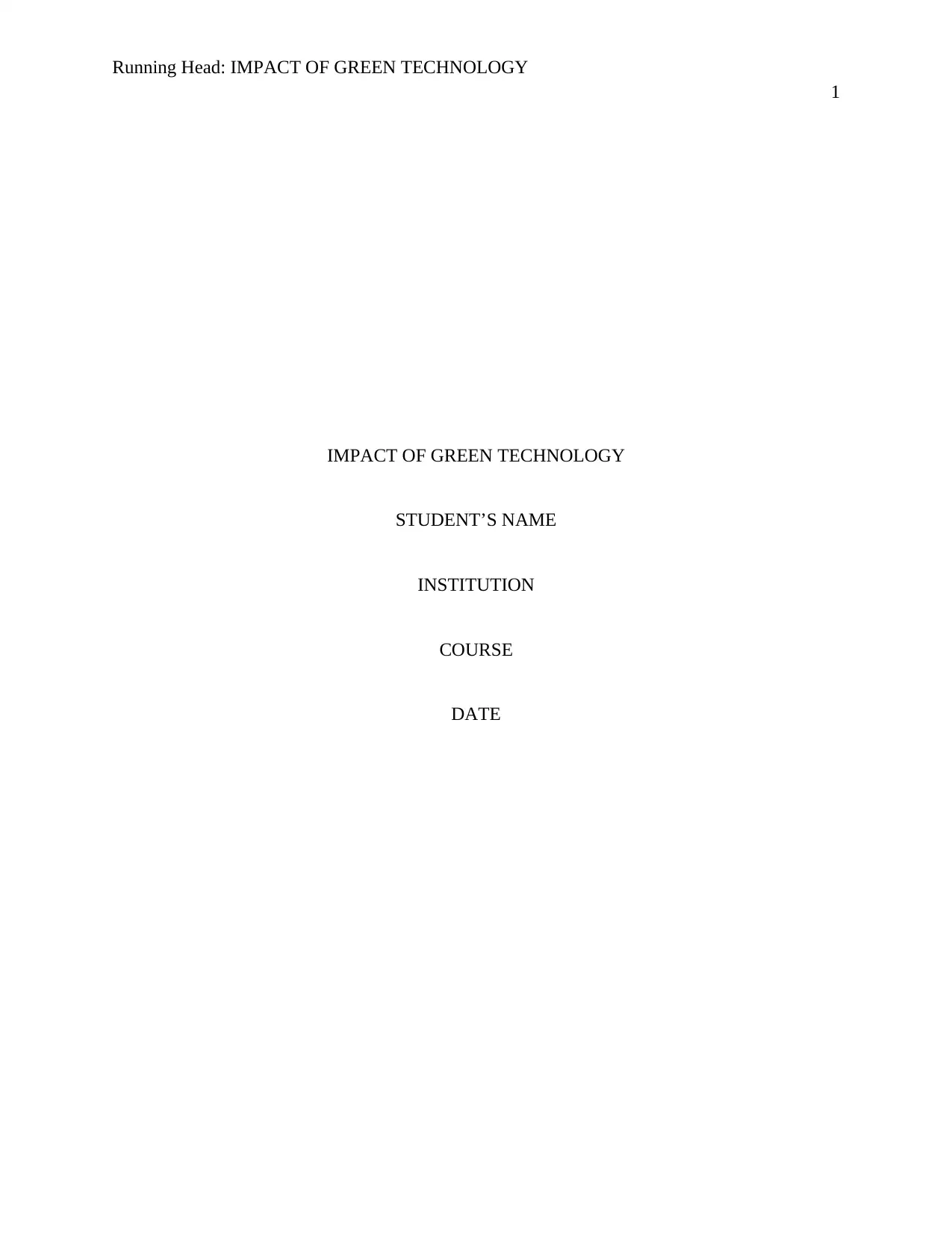
Running Head: IMPACT OF GREEN TECHNOLOGY
1
IMPACT OF GREEN TECHNOLOGY
STUDENT’S NAME
INSTITUTION
COURSE
DATE
1
IMPACT OF GREEN TECHNOLOGY
STUDENT’S NAME
INSTITUTION
COURSE
DATE
Paraphrase This Document
Need a fresh take? Get an instant paraphrase of this document with our AI Paraphraser
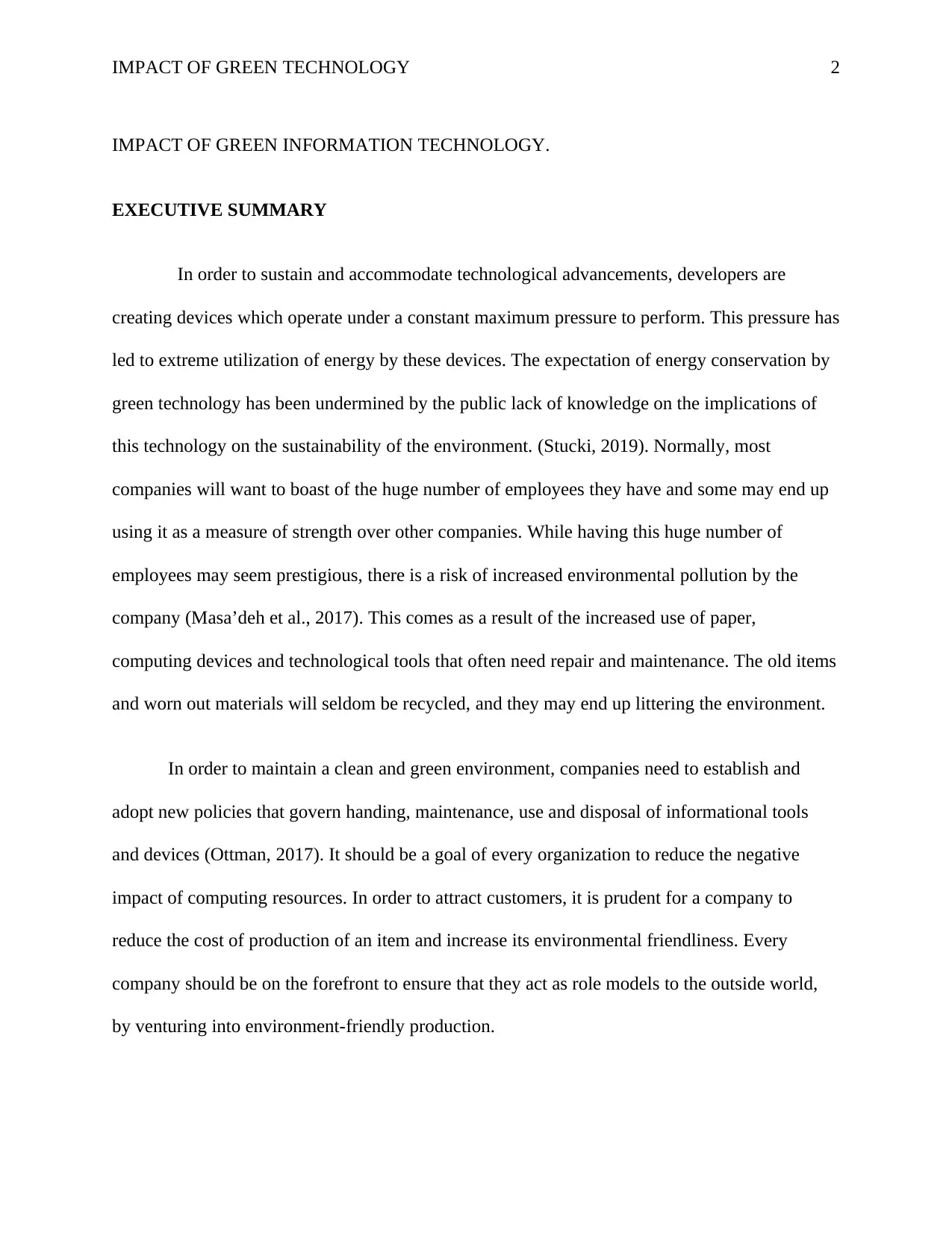
IMPACT OF GREEN TECHNOLOGY 2
IMPACT OF GREEN INFORMATION TECHNOLOGY.
EXECUTIVE SUMMARY
In order to sustain and accommodate technological advancements, developers are
creating devices which operate under a constant maximum pressure to perform. This pressure has
led to extreme utilization of energy by these devices. The expectation of energy conservation by
green technology has been undermined by the public lack of knowledge on the implications of
this technology on the sustainability of the environment. (Stucki, 2019). Normally, most
companies will want to boast of the huge number of employees they have and some may end up
using it as a measure of strength over other companies. While having this huge number of
employees may seem prestigious, there is a risk of increased environmental pollution by the
company (Masa’deh et al., 2017). This comes as a result of the increased use of paper,
computing devices and technological tools that often need repair and maintenance. The old items
and worn out materials will seldom be recycled, and they may end up littering the environment.
In order to maintain a clean and green environment, companies need to establish and
adopt new policies that govern handing, maintenance, use and disposal of informational tools
and devices (Ottman, 2017). It should be a goal of every organization to reduce the negative
impact of computing resources. In order to attract customers, it is prudent for a company to
reduce the cost of production of an item and increase its environmental friendliness. Every
company should be on the forefront to ensure that they act as role models to the outside world,
by venturing into environment-friendly production.
IMPACT OF GREEN INFORMATION TECHNOLOGY.
EXECUTIVE SUMMARY
In order to sustain and accommodate technological advancements, developers are
creating devices which operate under a constant maximum pressure to perform. This pressure has
led to extreme utilization of energy by these devices. The expectation of energy conservation by
green technology has been undermined by the public lack of knowledge on the implications of
this technology on the sustainability of the environment. (Stucki, 2019). Normally, most
companies will want to boast of the huge number of employees they have and some may end up
using it as a measure of strength over other companies. While having this huge number of
employees may seem prestigious, there is a risk of increased environmental pollution by the
company (Masa’deh et al., 2017). This comes as a result of the increased use of paper,
computing devices and technological tools that often need repair and maintenance. The old items
and worn out materials will seldom be recycled, and they may end up littering the environment.
In order to maintain a clean and green environment, companies need to establish and
adopt new policies that govern handing, maintenance, use and disposal of informational tools
and devices (Ottman, 2017). It should be a goal of every organization to reduce the negative
impact of computing resources. In order to attract customers, it is prudent for a company to
reduce the cost of production of an item and increase its environmental friendliness. Every
company should be on the forefront to ensure that they act as role models to the outside world,
by venturing into environment-friendly production.
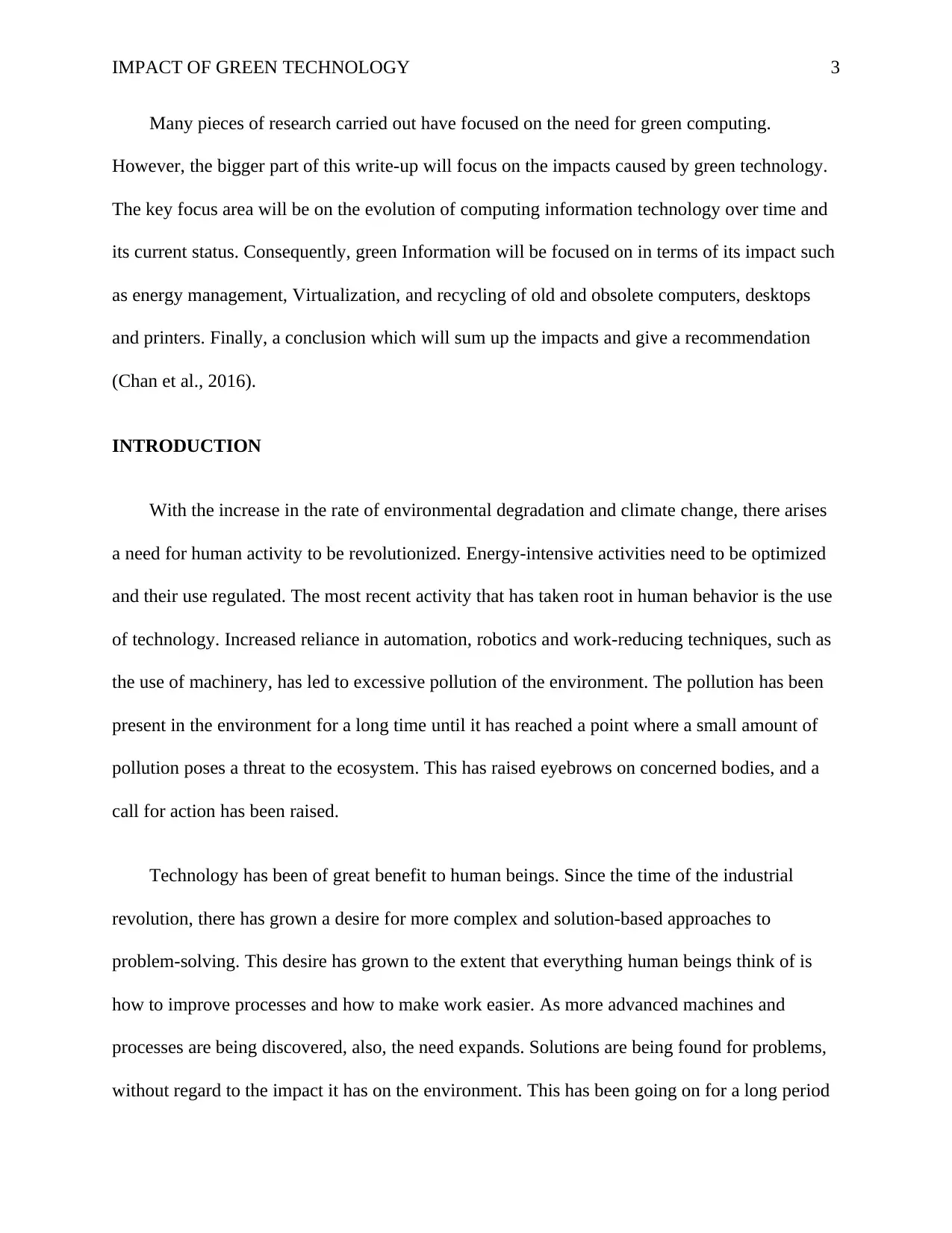
IMPACT OF GREEN TECHNOLOGY 3
Many pieces of research carried out have focused on the need for green computing.
However, the bigger part of this write-up will focus on the impacts caused by green technology.
The key focus area will be on the evolution of computing information technology over time and
its current status. Consequently, green Information will be focused on in terms of its impact such
as energy management, Virtualization, and recycling of old and obsolete computers, desktops
and printers. Finally, a conclusion which will sum up the impacts and give a recommendation
(Chan et al., 2016).
INTRODUCTION
With the increase in the rate of environmental degradation and climate change, there arises
a need for human activity to be revolutionized. Energy-intensive activities need to be optimized
and their use regulated. The most recent activity that has taken root in human behavior is the use
of technology. Increased reliance in automation, robotics and work-reducing techniques, such as
the use of machinery, has led to excessive pollution of the environment. The pollution has been
present in the environment for a long time until it has reached a point where a small amount of
pollution poses a threat to the ecosystem. This has raised eyebrows on concerned bodies, and a
call for action has been raised.
Technology has been of great benefit to human beings. Since the time of the industrial
revolution, there has grown a desire for more complex and solution-based approaches to
problem-solving. This desire has grown to the extent that everything human beings think of is
how to improve processes and how to make work easier. As more advanced machines and
processes are being discovered, also, the need expands. Solutions are being found for problems,
without regard to the impact it has on the environment. This has been going on for a long period
Many pieces of research carried out have focused on the need for green computing.
However, the bigger part of this write-up will focus on the impacts caused by green technology.
The key focus area will be on the evolution of computing information technology over time and
its current status. Consequently, green Information will be focused on in terms of its impact such
as energy management, Virtualization, and recycling of old and obsolete computers, desktops
and printers. Finally, a conclusion which will sum up the impacts and give a recommendation
(Chan et al., 2016).
INTRODUCTION
With the increase in the rate of environmental degradation and climate change, there arises
a need for human activity to be revolutionized. Energy-intensive activities need to be optimized
and their use regulated. The most recent activity that has taken root in human behavior is the use
of technology. Increased reliance in automation, robotics and work-reducing techniques, such as
the use of machinery, has led to excessive pollution of the environment. The pollution has been
present in the environment for a long time until it has reached a point where a small amount of
pollution poses a threat to the ecosystem. This has raised eyebrows on concerned bodies, and a
call for action has been raised.
Technology has been of great benefit to human beings. Since the time of the industrial
revolution, there has grown a desire for more complex and solution-based approaches to
problem-solving. This desire has grown to the extent that everything human beings think of is
how to improve processes and how to make work easier. As more advanced machines and
processes are being discovered, also, the need expands. Solutions are being found for problems,
without regard to the impact it has on the environment. This has been going on for a long period
⊘ This is a preview!⊘
Do you want full access?
Subscribe today to unlock all pages.

Trusted by 1+ million students worldwide
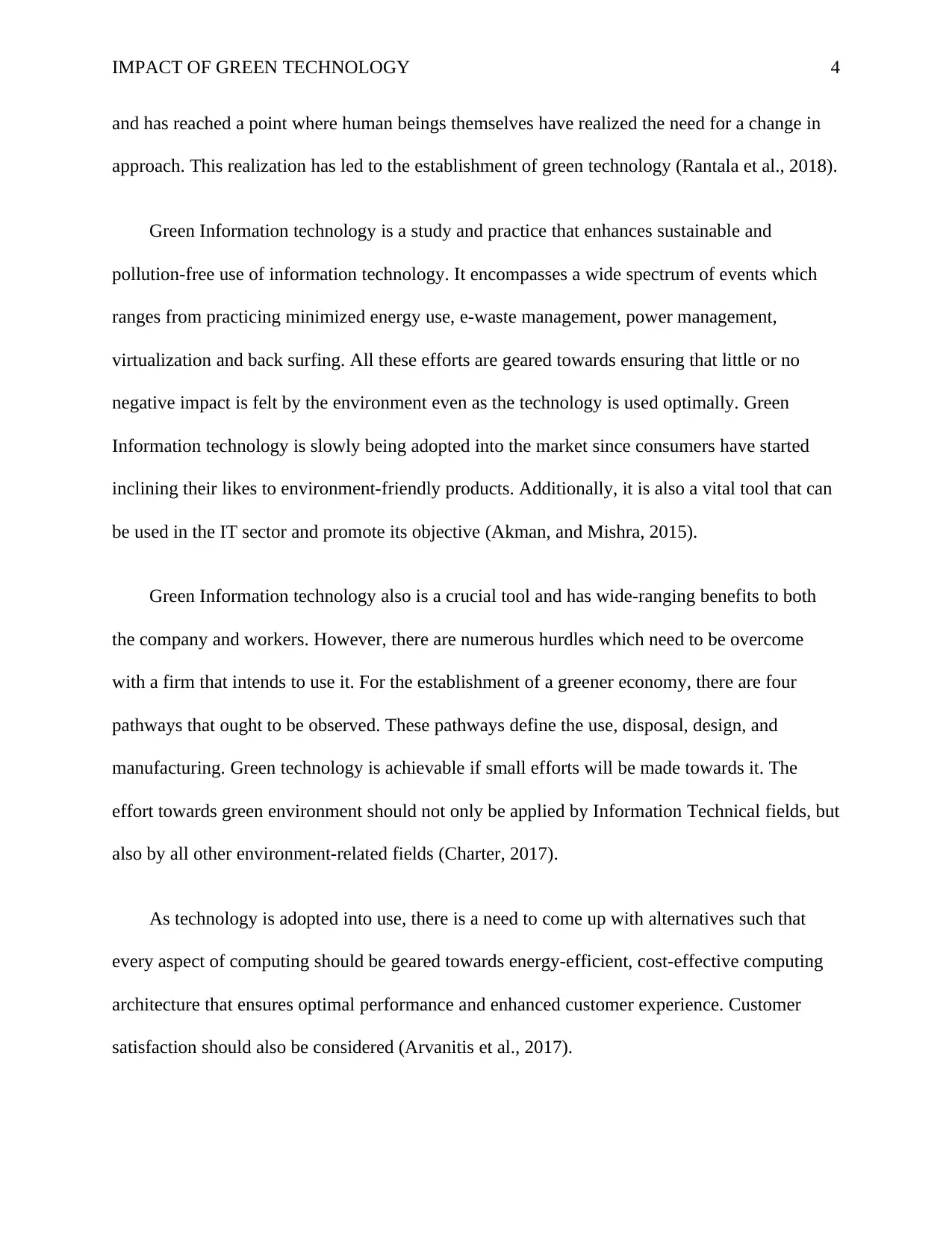
IMPACT OF GREEN TECHNOLOGY 4
and has reached a point where human beings themselves have realized the need for a change in
approach. This realization has led to the establishment of green technology (Rantala et al., 2018).
Green Information technology is a study and practice that enhances sustainable and
pollution-free use of information technology. It encompasses a wide spectrum of events which
ranges from practicing minimized energy use, e-waste management, power management,
virtualization and back surfing. All these efforts are geared towards ensuring that little or no
negative impact is felt by the environment even as the technology is used optimally. Green
Information technology is slowly being adopted into the market since consumers have started
inclining their likes to environment-friendly products. Additionally, it is also a vital tool that can
be used in the IT sector and promote its objective (Akman, and Mishra, 2015).
Green Information technology also is a crucial tool and has wide-ranging benefits to both
the company and workers. However, there are numerous hurdles which need to be overcome
with a firm that intends to use it. For the establishment of a greener economy, there are four
pathways that ought to be observed. These pathways define the use, disposal, design, and
manufacturing. Green technology is achievable if small efforts will be made towards it. The
effort towards green environment should not only be applied by Information Technical fields, but
also by all other environment-related fields (Charter, 2017).
As technology is adopted into use, there is a need to come up with alternatives such that
every aspect of computing should be geared towards energy-efficient, cost-effective computing
architecture that ensures optimal performance and enhanced customer experience. Customer
satisfaction should also be considered (Arvanitis et al., 2017).
and has reached a point where human beings themselves have realized the need for a change in
approach. This realization has led to the establishment of green technology (Rantala et al., 2018).
Green Information technology is a study and practice that enhances sustainable and
pollution-free use of information technology. It encompasses a wide spectrum of events which
ranges from practicing minimized energy use, e-waste management, power management,
virtualization and back surfing. All these efforts are geared towards ensuring that little or no
negative impact is felt by the environment even as the technology is used optimally. Green
Information technology is slowly being adopted into the market since consumers have started
inclining their likes to environment-friendly products. Additionally, it is also a vital tool that can
be used in the IT sector and promote its objective (Akman, and Mishra, 2015).
Green Information technology also is a crucial tool and has wide-ranging benefits to both
the company and workers. However, there are numerous hurdles which need to be overcome
with a firm that intends to use it. For the establishment of a greener economy, there are four
pathways that ought to be observed. These pathways define the use, disposal, design, and
manufacturing. Green technology is achievable if small efforts will be made towards it. The
effort towards green environment should not only be applied by Information Technical fields, but
also by all other environment-related fields (Charter, 2017).
As technology is adopted into use, there is a need to come up with alternatives such that
every aspect of computing should be geared towards energy-efficient, cost-effective computing
architecture that ensures optimal performance and enhanced customer experience. Customer
satisfaction should also be considered (Arvanitis et al., 2017).
Paraphrase This Document
Need a fresh take? Get an instant paraphrase of this document with our AI Paraphraser
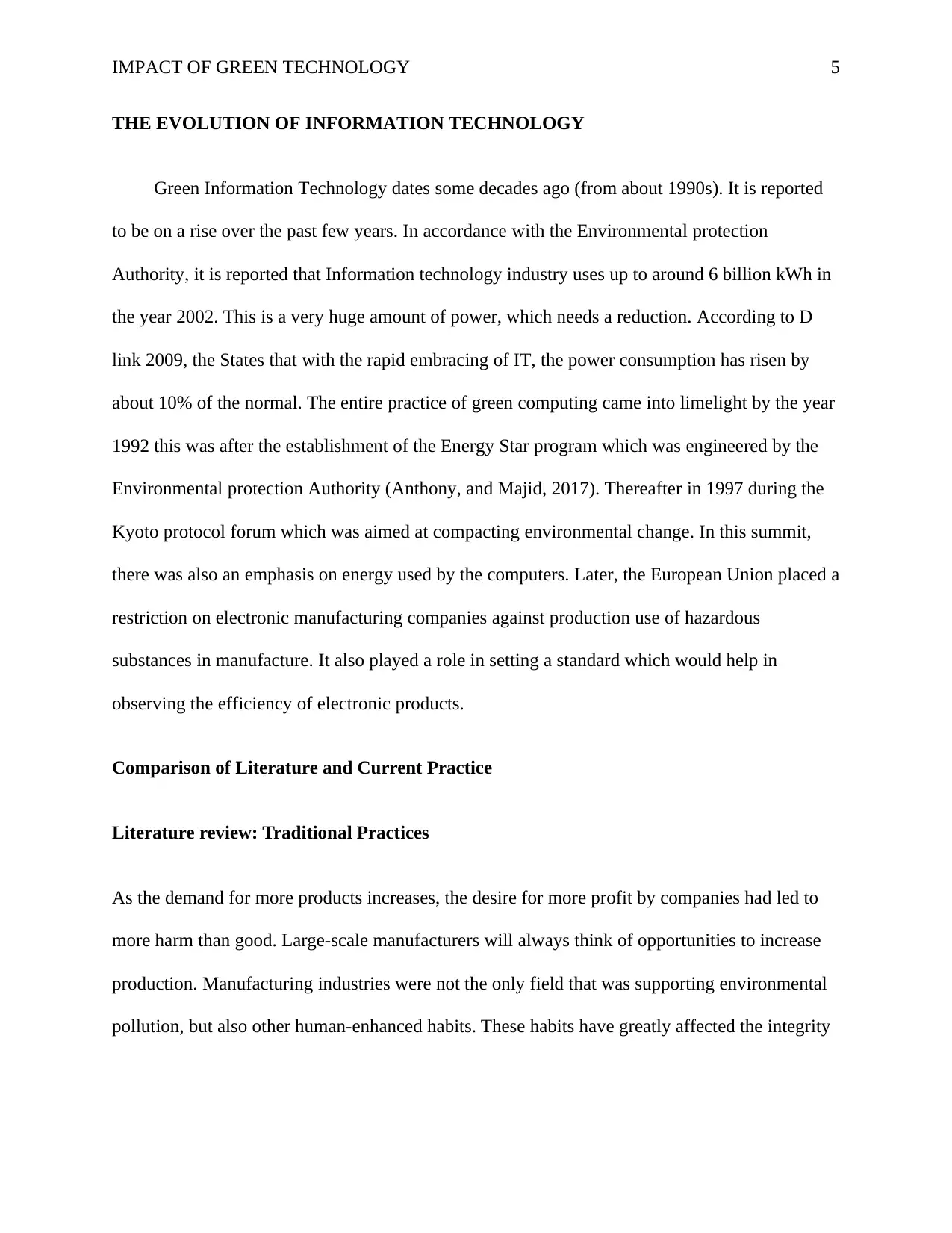
IMPACT OF GREEN TECHNOLOGY 5
THE EVOLUTION OF INFORMATION TECHNOLOGY
Green Information Technology dates some decades ago (from about 1990s). It is reported
to be on a rise over the past few years. In accordance with the Environmental protection
Authority, it is reported that Information technology industry uses up to around 6 billion kWh in
the year 2002. This is a very huge amount of power, which needs a reduction. According to D
link 2009, the States that with the rapid embracing of IT, the power consumption has risen by
about 10% of the normal. The entire practice of green computing came into limelight by the year
1992 this was after the establishment of the Energy Star program which was engineered by the
Environmental protection Authority (Anthony, and Majid, 2017). Thereafter in 1997 during the
Kyoto protocol forum which was aimed at compacting environmental change. In this summit,
there was also an emphasis on energy used by the computers. Later, the European Union placed a
restriction on electronic manufacturing companies against production use of hazardous
substances in manufacture. It also played a role in setting a standard which would help in
observing the efficiency of electronic products.
Comparison of Literature and Current Practice
Literature review: Traditional Practices
As the demand for more products increases, the desire for more profit by companies had led to
more harm than good. Large-scale manufacturers will always think of opportunities to increase
production. Manufacturing industries were not the only field that was supporting environmental
pollution, but also other human-enhanced habits. These habits have greatly affected the integrity
THE EVOLUTION OF INFORMATION TECHNOLOGY
Green Information Technology dates some decades ago (from about 1990s). It is reported
to be on a rise over the past few years. In accordance with the Environmental protection
Authority, it is reported that Information technology industry uses up to around 6 billion kWh in
the year 2002. This is a very huge amount of power, which needs a reduction. According to D
link 2009, the States that with the rapid embracing of IT, the power consumption has risen by
about 10% of the normal. The entire practice of green computing came into limelight by the year
1992 this was after the establishment of the Energy Star program which was engineered by the
Environmental protection Authority (Anthony, and Majid, 2017). Thereafter in 1997 during the
Kyoto protocol forum which was aimed at compacting environmental change. In this summit,
there was also an emphasis on energy used by the computers. Later, the European Union placed a
restriction on electronic manufacturing companies against production use of hazardous
substances in manufacture. It also played a role in setting a standard which would help in
observing the efficiency of electronic products.
Comparison of Literature and Current Practice
Literature review: Traditional Practices
As the demand for more products increases, the desire for more profit by companies had led to
more harm than good. Large-scale manufacturers will always think of opportunities to increase
production. Manufacturing industries were not the only field that was supporting environmental
pollution, but also other human-enhanced habits. These habits have greatly affected the integrity
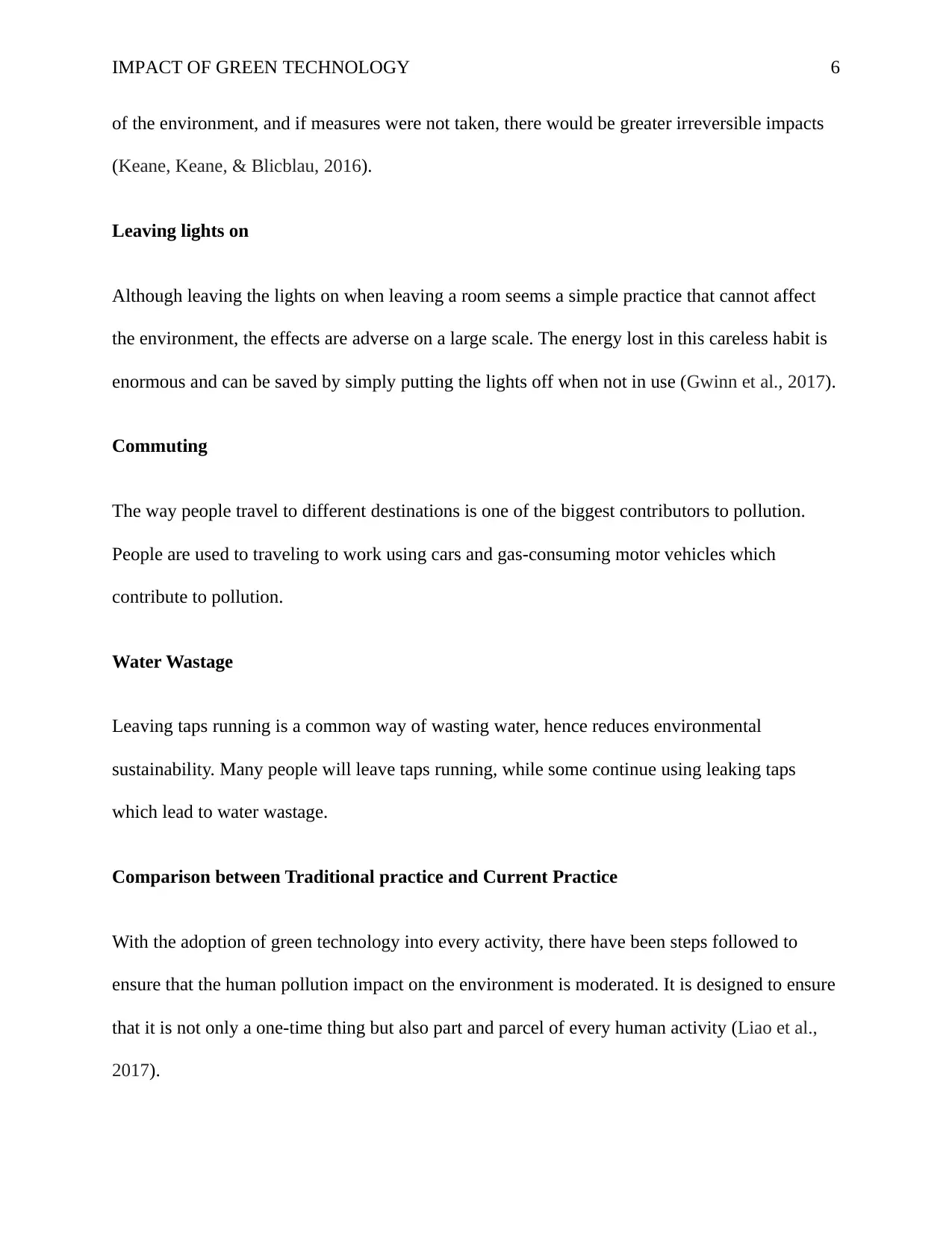
IMPACT OF GREEN TECHNOLOGY 6
of the environment, and if measures were not taken, there would be greater irreversible impacts
(Keane, Keane, & Blicblau, 2016).
Leaving lights on
Although leaving the lights on when leaving a room seems a simple practice that cannot affect
the environment, the effects are adverse on a large scale. The energy lost in this careless habit is
enormous and can be saved by simply putting the lights off when not in use (Gwinn et al., 2017).
Commuting
The way people travel to different destinations is one of the biggest contributors to pollution.
People are used to traveling to work using cars and gas-consuming motor vehicles which
contribute to pollution.
Water Wastage
Leaving taps running is a common way of wasting water, hence reduces environmental
sustainability. Many people will leave taps running, while some continue using leaking taps
which lead to water wastage.
Comparison between Traditional practice and Current Practice
With the adoption of green technology into every activity, there have been steps followed to
ensure that the human pollution impact on the environment is moderated. It is designed to ensure
that it is not only a one-time thing but also part and parcel of every human activity (Liao et al.,
2017).
of the environment, and if measures were not taken, there would be greater irreversible impacts
(Keane, Keane, & Blicblau, 2016).
Leaving lights on
Although leaving the lights on when leaving a room seems a simple practice that cannot affect
the environment, the effects are adverse on a large scale. The energy lost in this careless habit is
enormous and can be saved by simply putting the lights off when not in use (Gwinn et al., 2017).
Commuting
The way people travel to different destinations is one of the biggest contributors to pollution.
People are used to traveling to work using cars and gas-consuming motor vehicles which
contribute to pollution.
Water Wastage
Leaving taps running is a common way of wasting water, hence reduces environmental
sustainability. Many people will leave taps running, while some continue using leaking taps
which lead to water wastage.
Comparison between Traditional practice and Current Practice
With the adoption of green technology into every activity, there have been steps followed to
ensure that the human pollution impact on the environment is moderated. It is designed to ensure
that it is not only a one-time thing but also part and parcel of every human activity (Liao et al.,
2017).
⊘ This is a preview!⊘
Do you want full access?
Subscribe today to unlock all pages.

Trusted by 1+ million students worldwide
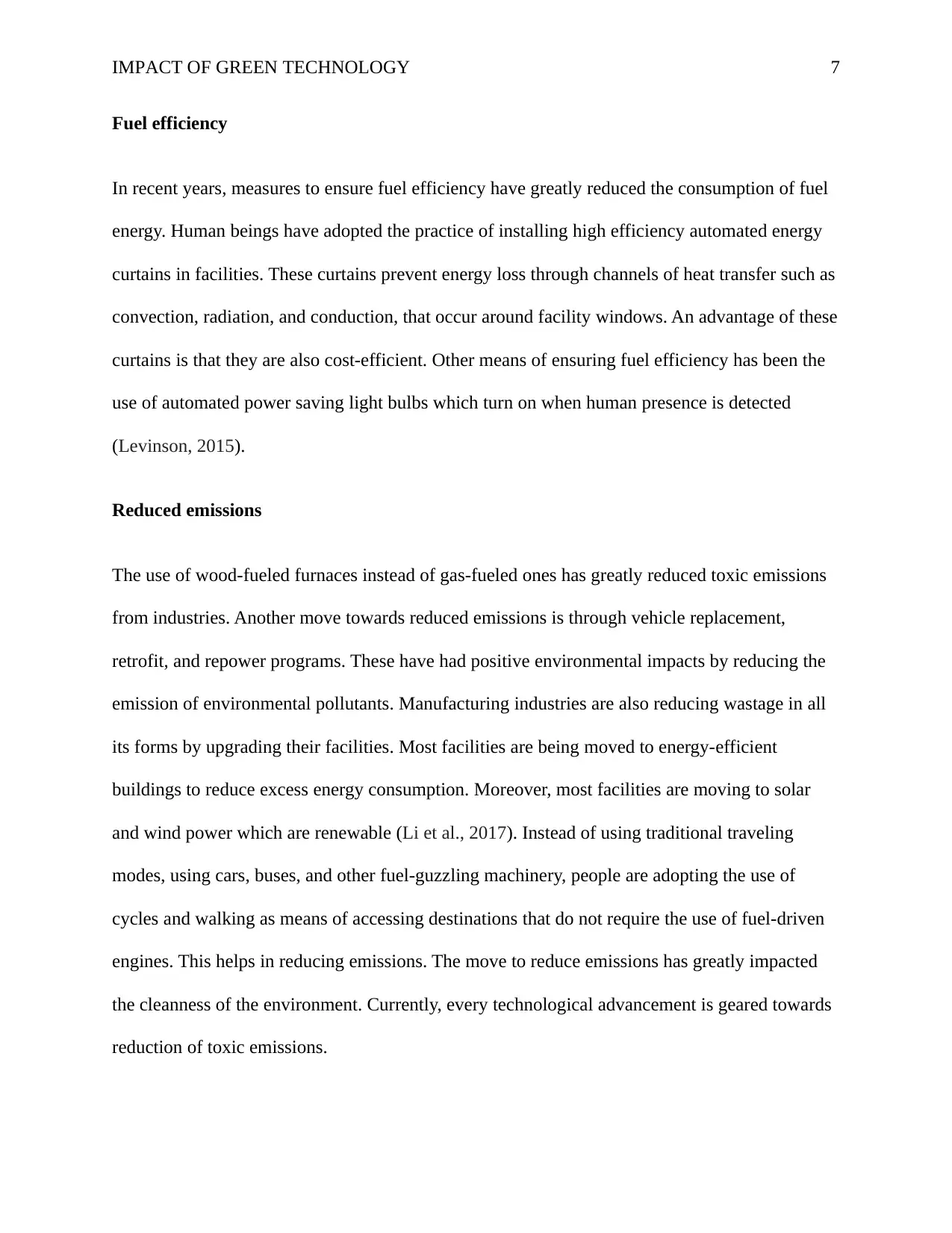
IMPACT OF GREEN TECHNOLOGY 7
Fuel efficiency
In recent years, measures to ensure fuel efficiency have greatly reduced the consumption of fuel
energy. Human beings have adopted the practice of installing high efficiency automated energy
curtains in facilities. These curtains prevent energy loss through channels of heat transfer such as
convection, radiation, and conduction, that occur around facility windows. An advantage of these
curtains is that they are also cost-efficient. Other means of ensuring fuel efficiency has been the
use of automated power saving light bulbs which turn on when human presence is detected
(Levinson, 2015).
Reduced emissions
The use of wood-fueled furnaces instead of gas-fueled ones has greatly reduced toxic emissions
from industries. Another move towards reduced emissions is through vehicle replacement,
retrofit, and repower programs. These have had positive environmental impacts by reducing the
emission of environmental pollutants. Manufacturing industries are also reducing wastage in all
its forms by upgrading their facilities. Most facilities are being moved to energy-efficient
buildings to reduce excess energy consumption. Moreover, most facilities are moving to solar
and wind power which are renewable (Li et al., 2017). Instead of using traditional traveling
modes, using cars, buses, and other fuel-guzzling machinery, people are adopting the use of
cycles and walking as means of accessing destinations that do not require the use of fuel-driven
engines. This helps in reducing emissions. The move to reduce emissions has greatly impacted
the cleanness of the environment. Currently, every technological advancement is geared towards
reduction of toxic emissions.
Fuel efficiency
In recent years, measures to ensure fuel efficiency have greatly reduced the consumption of fuel
energy. Human beings have adopted the practice of installing high efficiency automated energy
curtains in facilities. These curtains prevent energy loss through channels of heat transfer such as
convection, radiation, and conduction, that occur around facility windows. An advantage of these
curtains is that they are also cost-efficient. Other means of ensuring fuel efficiency has been the
use of automated power saving light bulbs which turn on when human presence is detected
(Levinson, 2015).
Reduced emissions
The use of wood-fueled furnaces instead of gas-fueled ones has greatly reduced toxic emissions
from industries. Another move towards reduced emissions is through vehicle replacement,
retrofit, and repower programs. These have had positive environmental impacts by reducing the
emission of environmental pollutants. Manufacturing industries are also reducing wastage in all
its forms by upgrading their facilities. Most facilities are being moved to energy-efficient
buildings to reduce excess energy consumption. Moreover, most facilities are moving to solar
and wind power which are renewable (Li et al., 2017). Instead of using traditional traveling
modes, using cars, buses, and other fuel-guzzling machinery, people are adopting the use of
cycles and walking as means of accessing destinations that do not require the use of fuel-driven
engines. This helps in reducing emissions. The move to reduce emissions has greatly impacted
the cleanness of the environment. Currently, every technological advancement is geared towards
reduction of toxic emissions.
Paraphrase This Document
Need a fresh take? Get an instant paraphrase of this document with our AI Paraphraser
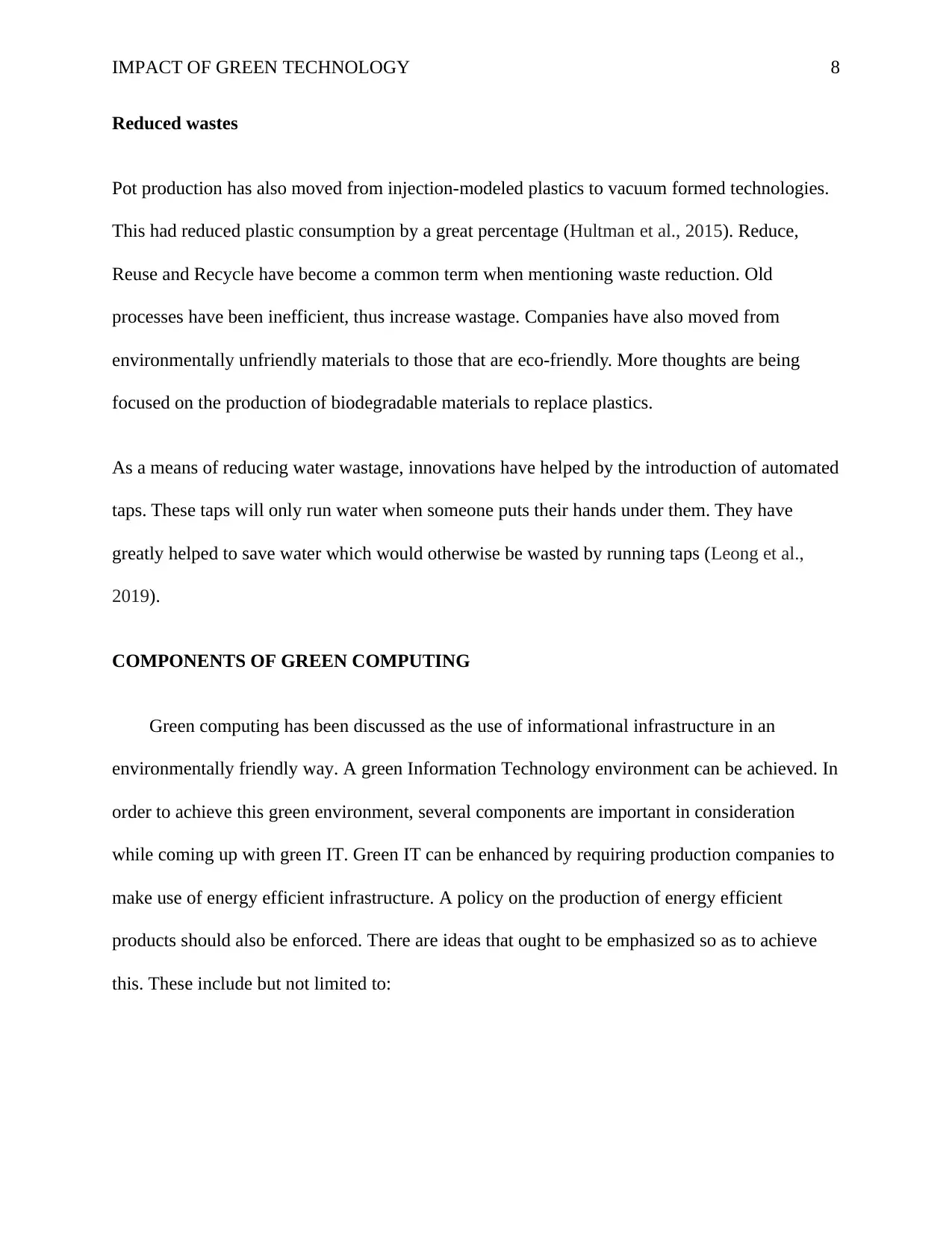
IMPACT OF GREEN TECHNOLOGY 8
Reduced wastes
Pot production has also moved from injection-modeled plastics to vacuum formed technologies.
This had reduced plastic consumption by a great percentage (Hultman et al., 2015). Reduce,
Reuse and Recycle have become a common term when mentioning waste reduction. Old
processes have been inefficient, thus increase wastage. Companies have also moved from
environmentally unfriendly materials to those that are eco-friendly. More thoughts are being
focused on the production of biodegradable materials to replace plastics.
As a means of reducing water wastage, innovations have helped by the introduction of automated
taps. These taps will only run water when someone puts their hands under them. They have
greatly helped to save water which would otherwise be wasted by running taps (Leong et al.,
2019).
COMPONENTS OF GREEN COMPUTING
Green computing has been discussed as the use of informational infrastructure in an
environmentally friendly way. A green Information Technology environment can be achieved. In
order to achieve this green environment, several components are important in consideration
while coming up with green IT. Green IT can be enhanced by requiring production companies to
make use of energy efficient infrastructure. A policy on the production of energy efficient
products should also be enforced. There are ideas that ought to be emphasized so as to achieve
this. These include but not limited to:
Reduced wastes
Pot production has also moved from injection-modeled plastics to vacuum formed technologies.
This had reduced plastic consumption by a great percentage (Hultman et al., 2015). Reduce,
Reuse and Recycle have become a common term when mentioning waste reduction. Old
processes have been inefficient, thus increase wastage. Companies have also moved from
environmentally unfriendly materials to those that are eco-friendly. More thoughts are being
focused on the production of biodegradable materials to replace plastics.
As a means of reducing water wastage, innovations have helped by the introduction of automated
taps. These taps will only run water when someone puts their hands under them. They have
greatly helped to save water which would otherwise be wasted by running taps (Leong et al.,
2019).
COMPONENTS OF GREEN COMPUTING
Green computing has been discussed as the use of informational infrastructure in an
environmentally friendly way. A green Information Technology environment can be achieved. In
order to achieve this green environment, several components are important in consideration
while coming up with green IT. Green IT can be enhanced by requiring production companies to
make use of energy efficient infrastructure. A policy on the production of energy efficient
products should also be enforced. There are ideas that ought to be emphasized so as to achieve
this. These include but not limited to:
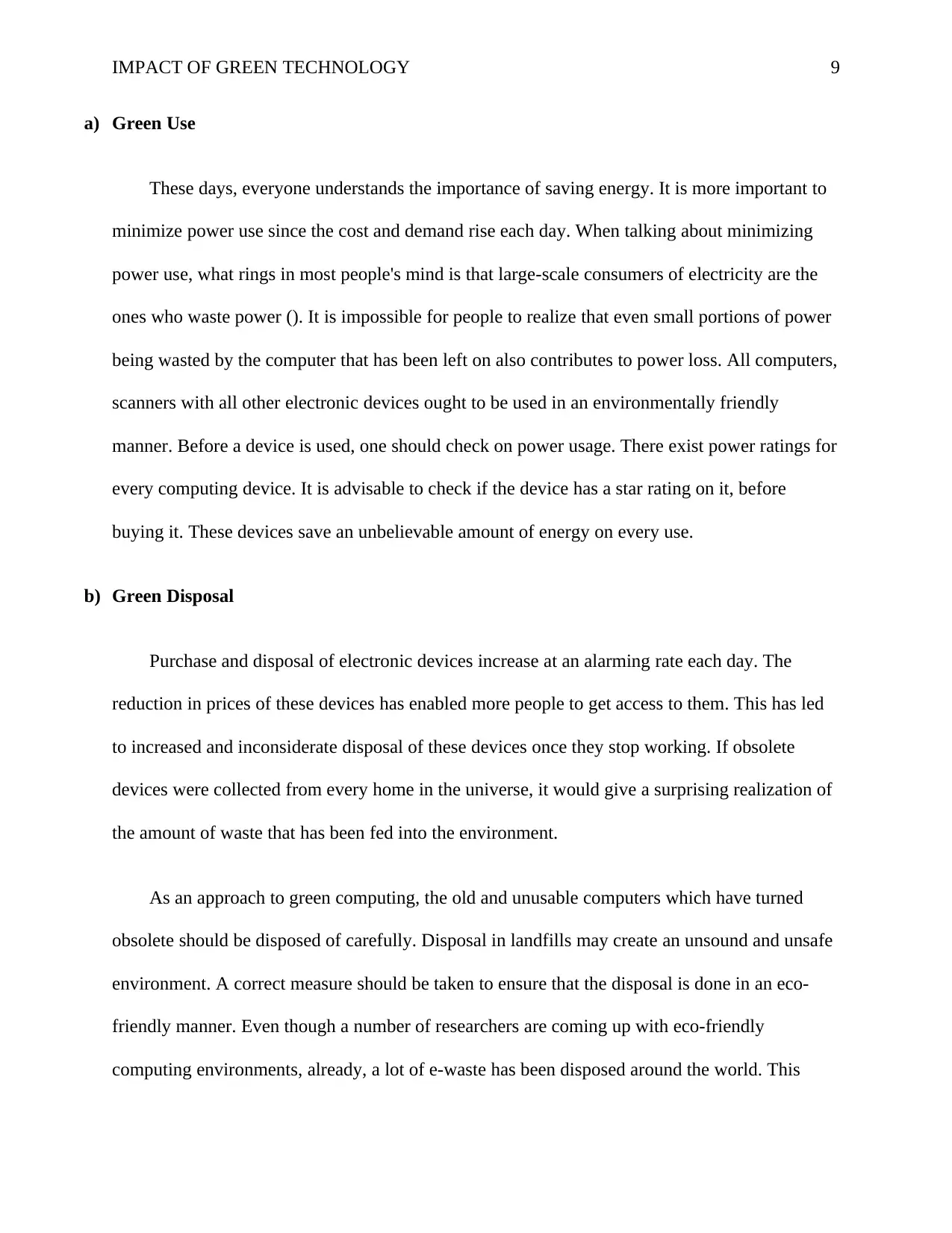
IMPACT OF GREEN TECHNOLOGY 9
a) Green Use
These days, everyone understands the importance of saving energy. It is more important to
minimize power use since the cost and demand rise each day. When talking about minimizing
power use, what rings in most people's mind is that large-scale consumers of electricity are the
ones who waste power (). It is impossible for people to realize that even small portions of power
being wasted by the computer that has been left on also contributes to power loss. All computers,
scanners with all other electronic devices ought to be used in an environmentally friendly
manner. Before a device is used, one should check on power usage. There exist power ratings for
every computing device. It is advisable to check if the device has a star rating on it, before
buying it. These devices save an unbelievable amount of energy on every use.
b) Green Disposal
Purchase and disposal of electronic devices increase at an alarming rate each day. The
reduction in prices of these devices has enabled more people to get access to them. This has led
to increased and inconsiderate disposal of these devices once they stop working. If obsolete
devices were collected from every home in the universe, it would give a surprising realization of
the amount of waste that has been fed into the environment.
As an approach to green computing, the old and unusable computers which have turned
obsolete should be disposed of carefully. Disposal in landfills may create an unsound and unsafe
environment. A correct measure should be taken to ensure that the disposal is done in an eco-
friendly manner. Even though a number of researchers are coming up with eco-friendly
computing environments, already, a lot of e-waste has been disposed around the world. This
a) Green Use
These days, everyone understands the importance of saving energy. It is more important to
minimize power use since the cost and demand rise each day. When talking about minimizing
power use, what rings in most people's mind is that large-scale consumers of electricity are the
ones who waste power (). It is impossible for people to realize that even small portions of power
being wasted by the computer that has been left on also contributes to power loss. All computers,
scanners with all other electronic devices ought to be used in an environmentally friendly
manner. Before a device is used, one should check on power usage. There exist power ratings for
every computing device. It is advisable to check if the device has a star rating on it, before
buying it. These devices save an unbelievable amount of energy on every use.
b) Green Disposal
Purchase and disposal of electronic devices increase at an alarming rate each day. The
reduction in prices of these devices has enabled more people to get access to them. This has led
to increased and inconsiderate disposal of these devices once they stop working. If obsolete
devices were collected from every home in the universe, it would give a surprising realization of
the amount of waste that has been fed into the environment.
As an approach to green computing, the old and unusable computers which have turned
obsolete should be disposed of carefully. Disposal in landfills may create an unsound and unsafe
environment. A correct measure should be taken to ensure that the disposal is done in an eco-
friendly manner. Even though a number of researchers are coming up with eco-friendly
computing environments, already, a lot of e-waste has been disposed around the world. This
⊘ This is a preview!⊘
Do you want full access?
Subscribe today to unlock all pages.

Trusted by 1+ million students worldwide
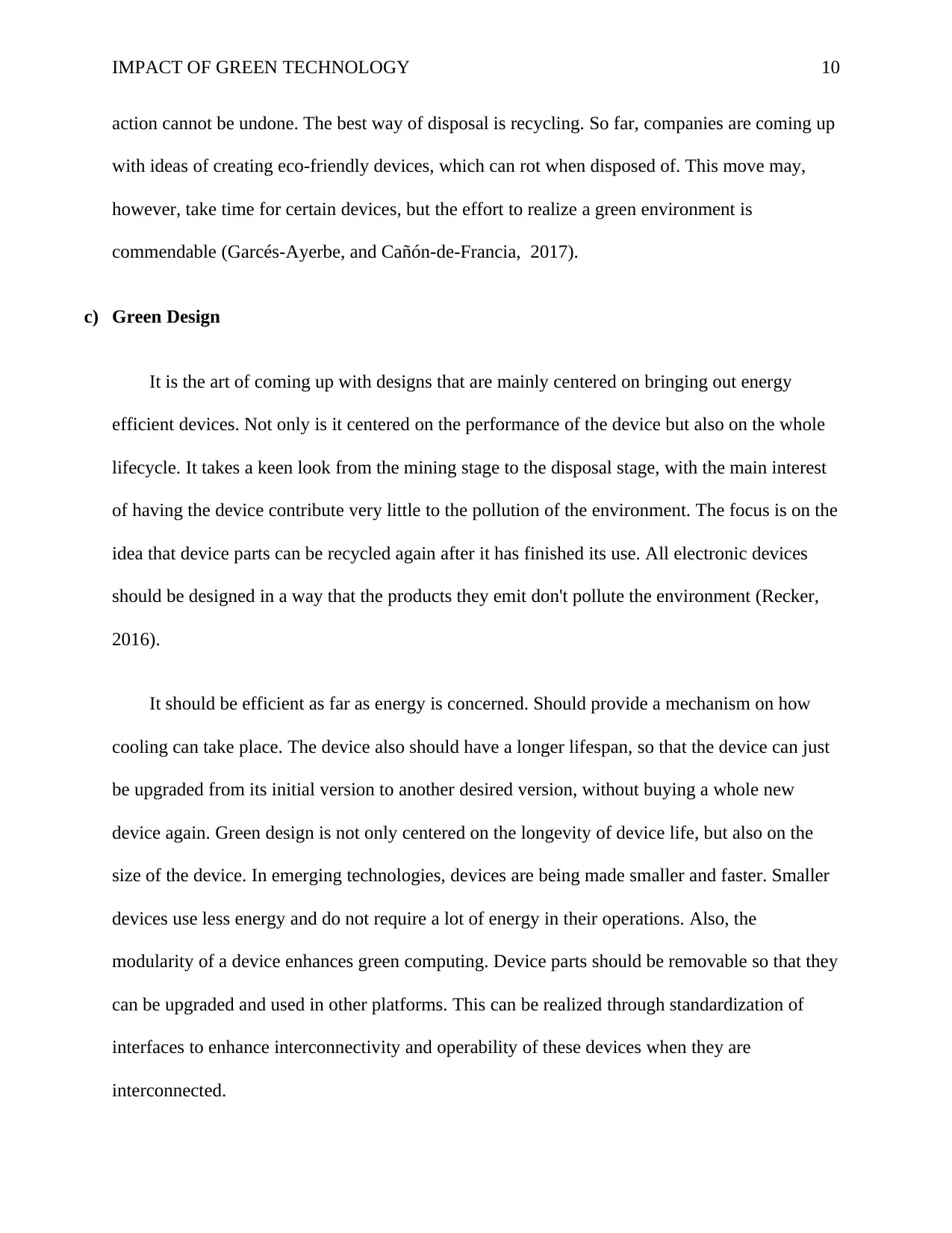
IMPACT OF GREEN TECHNOLOGY 10
action cannot be undone. The best way of disposal is recycling. So far, companies are coming up
with ideas of creating eco-friendly devices, which can rot when disposed of. This move may,
however, take time for certain devices, but the effort to realize a green environment is
commendable (Garcés-Ayerbe, and Cañón-de-Francia, 2017).
c) Green Design
It is the art of coming up with designs that are mainly centered on bringing out energy
efficient devices. Not only is it centered on the performance of the device but also on the whole
lifecycle. It takes a keen look from the mining stage to the disposal stage, with the main interest
of having the device contribute very little to the pollution of the environment. The focus is on the
idea that device parts can be recycled again after it has finished its use. All electronic devices
should be designed in a way that the products they emit don't pollute the environment (Recker,
2016).
It should be efficient as far as energy is concerned. Should provide a mechanism on how
cooling can take place. The device also should have a longer lifespan, so that the device can just
be upgraded from its initial version to another desired version, without buying a whole new
device again. Green design is not only centered on the longevity of device life, but also on the
size of the device. In emerging technologies, devices are being made smaller and faster. Smaller
devices use less energy and do not require a lot of energy in their operations. Also, the
modularity of a device enhances green computing. Device parts should be removable so that they
can be upgraded and used in other platforms. This can be realized through standardization of
interfaces to enhance interconnectivity and operability of these devices when they are
interconnected.
action cannot be undone. The best way of disposal is recycling. So far, companies are coming up
with ideas of creating eco-friendly devices, which can rot when disposed of. This move may,
however, take time for certain devices, but the effort to realize a green environment is
commendable (Garcés-Ayerbe, and Cañón-de-Francia, 2017).
c) Green Design
It is the art of coming up with designs that are mainly centered on bringing out energy
efficient devices. Not only is it centered on the performance of the device but also on the whole
lifecycle. It takes a keen look from the mining stage to the disposal stage, with the main interest
of having the device contribute very little to the pollution of the environment. The focus is on the
idea that device parts can be recycled again after it has finished its use. All electronic devices
should be designed in a way that the products they emit don't pollute the environment (Recker,
2016).
It should be efficient as far as energy is concerned. Should provide a mechanism on how
cooling can take place. The device also should have a longer lifespan, so that the device can just
be upgraded from its initial version to another desired version, without buying a whole new
device again. Green design is not only centered on the longevity of device life, but also on the
size of the device. In emerging technologies, devices are being made smaller and faster. Smaller
devices use less energy and do not require a lot of energy in their operations. Also, the
modularity of a device enhances green computing. Device parts should be removable so that they
can be upgraded and used in other platforms. This can be realized through standardization of
interfaces to enhance interconnectivity and operability of these devices when they are
interconnected.
Paraphrase This Document
Need a fresh take? Get an instant paraphrase of this document with our AI Paraphraser
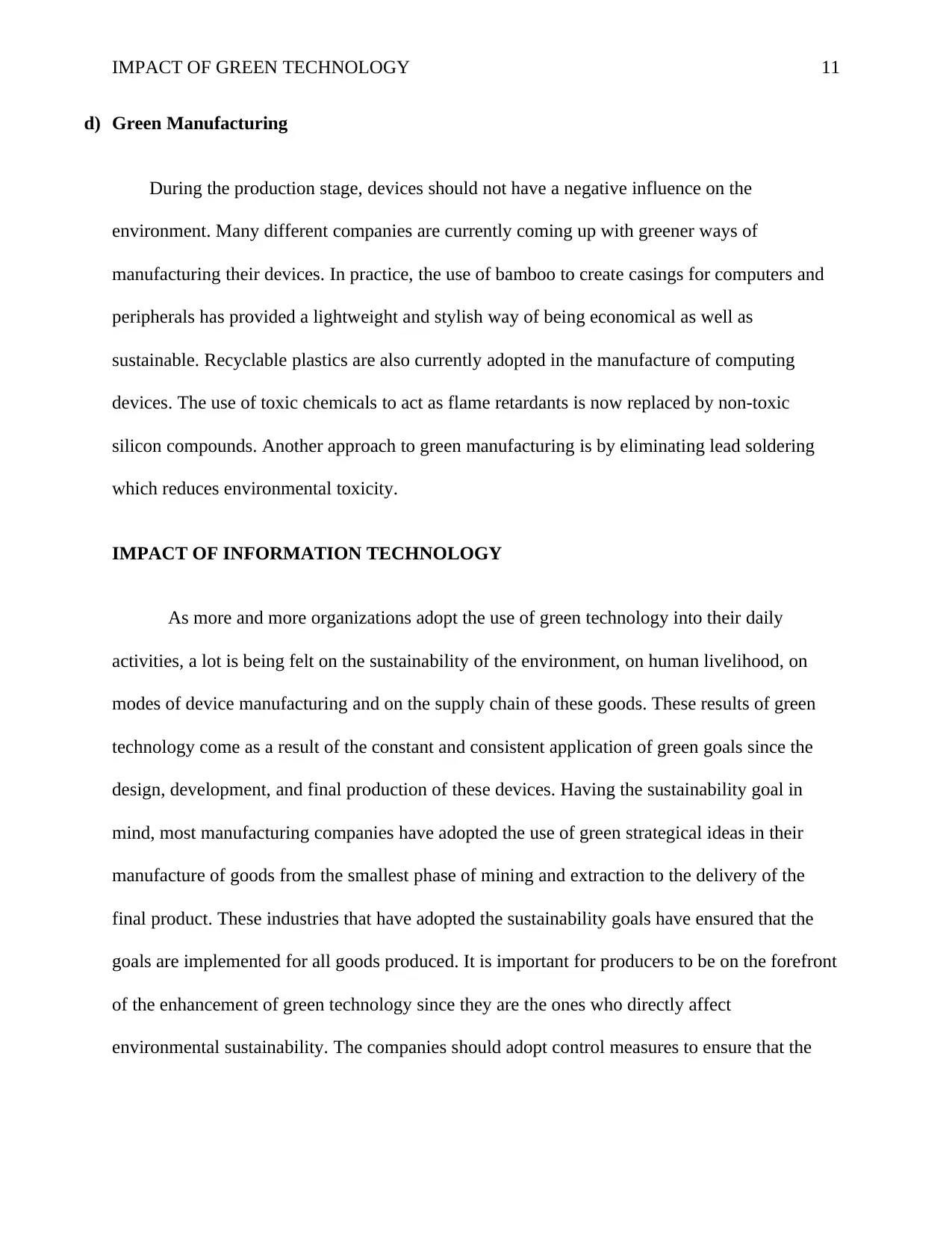
IMPACT OF GREEN TECHNOLOGY 11
d) Green Manufacturing
During the production stage, devices should not have a negative influence on the
environment. Many different companies are currently coming up with greener ways of
manufacturing their devices. In practice, the use of bamboo to create casings for computers and
peripherals has provided a lightweight and stylish way of being economical as well as
sustainable. Recyclable plastics are also currently adopted in the manufacture of computing
devices. The use of toxic chemicals to act as flame retardants is now replaced by non-toxic
silicon compounds. Another approach to green manufacturing is by eliminating lead soldering
which reduces environmental toxicity.
IMPACT OF INFORMATION TECHNOLOGY
As more and more organizations adopt the use of green technology into their daily
activities, a lot is being felt on the sustainability of the environment, on human livelihood, on
modes of device manufacturing and on the supply chain of these goods. These results of green
technology come as a result of the constant and consistent application of green goals since the
design, development, and final production of these devices. Having the sustainability goal in
mind, most manufacturing companies have adopted the use of green strategical ideas in their
manufacture of goods from the smallest phase of mining and extraction to the delivery of the
final product. These industries that have adopted the sustainability goals have ensured that the
goals are implemented for all goods produced. It is important for producers to be on the forefront
of the enhancement of green technology since they are the ones who directly affect
environmental sustainability. The companies should adopt control measures to ensure that the
d) Green Manufacturing
During the production stage, devices should not have a negative influence on the
environment. Many different companies are currently coming up with greener ways of
manufacturing their devices. In practice, the use of bamboo to create casings for computers and
peripherals has provided a lightweight and stylish way of being economical as well as
sustainable. Recyclable plastics are also currently adopted in the manufacture of computing
devices. The use of toxic chemicals to act as flame retardants is now replaced by non-toxic
silicon compounds. Another approach to green manufacturing is by eliminating lead soldering
which reduces environmental toxicity.
IMPACT OF INFORMATION TECHNOLOGY
As more and more organizations adopt the use of green technology into their daily
activities, a lot is being felt on the sustainability of the environment, on human livelihood, on
modes of device manufacturing and on the supply chain of these goods. These results of green
technology come as a result of the constant and consistent application of green goals since the
design, development, and final production of these devices. Having the sustainability goal in
mind, most manufacturing companies have adopted the use of green strategical ideas in their
manufacture of goods from the smallest phase of mining and extraction to the delivery of the
final product. These industries that have adopted the sustainability goals have ensured that the
goals are implemented for all goods produced. It is important for producers to be on the forefront
of the enhancement of green technology since they are the ones who directly affect
environmental sustainability. The companies should adopt control measures to ensure that the
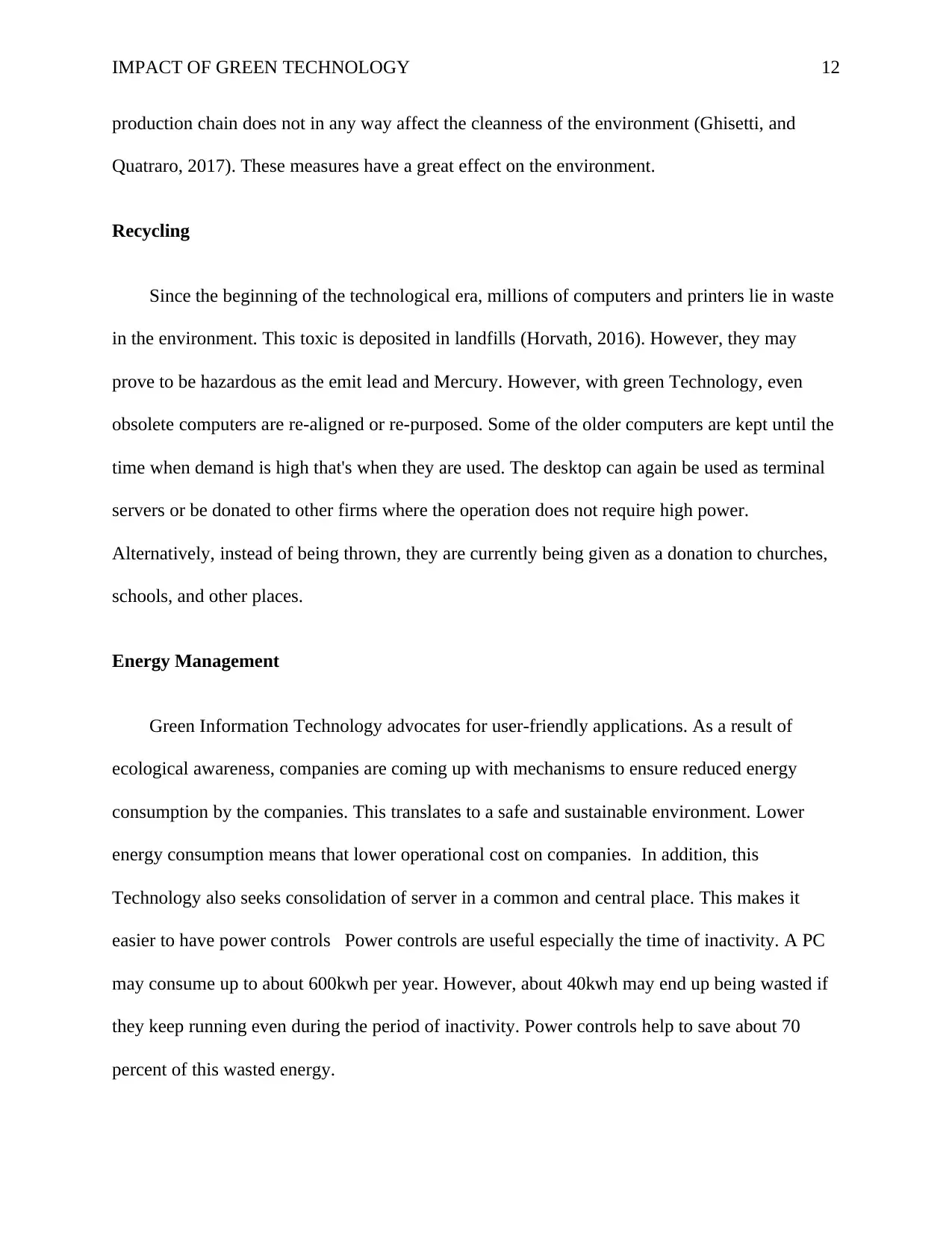
IMPACT OF GREEN TECHNOLOGY 12
production chain does not in any way affect the cleanness of the environment (Ghisetti, and
Quatraro, 2017). These measures have a great effect on the environment.
Recycling
Since the beginning of the technological era, millions of computers and printers lie in waste
in the environment. This toxic is deposited in landfills (Horvath, 2016). However, they may
prove to be hazardous as the emit lead and Mercury. However, with green Technology, even
obsolete computers are re-aligned or re-purposed. Some of the older computers are kept until the
time when demand is high that's when they are used. The desktop can again be used as terminal
servers or be donated to other firms where the operation does not require high power.
Alternatively, instead of being thrown, they are currently being given as a donation to churches,
schools, and other places.
Energy Management
Green Information Technology advocates for user-friendly applications. As a result of
ecological awareness, companies are coming up with mechanisms to ensure reduced energy
consumption by the companies. This translates to a safe and sustainable environment. Lower
energy consumption means that lower operational cost on companies. In addition, this
Technology also seeks consolidation of server in a common and central place. This makes it
easier to have power controls Power controls are useful especially the time of inactivity. A PC
may consume up to about 600kwh per year. However, about 40kwh may end up being wasted if
they keep running even during the period of inactivity. Power controls help to save about 70
percent of this wasted energy.
production chain does not in any way affect the cleanness of the environment (Ghisetti, and
Quatraro, 2017). These measures have a great effect on the environment.
Recycling
Since the beginning of the technological era, millions of computers and printers lie in waste
in the environment. This toxic is deposited in landfills (Horvath, 2016). However, they may
prove to be hazardous as the emit lead and Mercury. However, with green Technology, even
obsolete computers are re-aligned or re-purposed. Some of the older computers are kept until the
time when demand is high that's when they are used. The desktop can again be used as terminal
servers or be donated to other firms where the operation does not require high power.
Alternatively, instead of being thrown, they are currently being given as a donation to churches,
schools, and other places.
Energy Management
Green Information Technology advocates for user-friendly applications. As a result of
ecological awareness, companies are coming up with mechanisms to ensure reduced energy
consumption by the companies. This translates to a safe and sustainable environment. Lower
energy consumption means that lower operational cost on companies. In addition, this
Technology also seeks consolidation of server in a common and central place. This makes it
easier to have power controls Power controls are useful especially the time of inactivity. A PC
may consume up to about 600kwh per year. However, about 40kwh may end up being wasted if
they keep running even during the period of inactivity. Power controls help to save about 70
percent of this wasted energy.
⊘ This is a preview!⊘
Do you want full access?
Subscribe today to unlock all pages.

Trusted by 1+ million students worldwide
1 out of 24
Related Documents
Your All-in-One AI-Powered Toolkit for Academic Success.
+13062052269
info@desklib.com
Available 24*7 on WhatsApp / Email
![[object Object]](/_next/static/media/star-bottom.7253800d.svg)
Unlock your academic potential
Copyright © 2020–2025 A2Z Services. All Rights Reserved. Developed and managed by ZUCOL.





